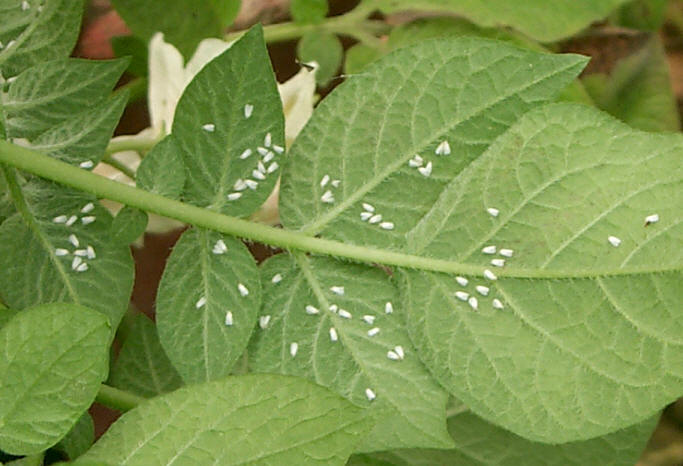

Whiteflies (Homoptera: Aleyrodidae) BACK
Species complex


Bemisia tabaci Trialeurodes vaporariorum
Distribution: Cotton whitefly is distributed throughout the northern and western regions of the Indian sub- continent, whereas, green house whitefly is cosmopolitan.
Host range: Potato, tomato, chilli, cotton, capsicum, okra, melon, egg plant, crucifers, cucurbits, tobacco and some weeds.
 Nature
of damage and symptoms:
Nature
of damage and symptoms:

White flies on undersurface of leaves
· Nymphs and adults suck the cell sap.
· Infected plants exhibit one or combination of the symptoms like vein yellowing, inter-vein yellowing, yellow blotching of leaves, leaf yellowing, yellow mosaic of leaves, leaf curling, vein thickening, leaf cupping, plant stunting.
· Lower the vitality of the plant.
· They also excrete honey dew on which sooty mould grows which interferes with the photosynthesis of the plants.
· Affected plants give a sickly black appearance.
· B. tabaci also transmits a number of viruses including Gemini viruses (PALCV).
Identification:

Whitefly nymphs
Nymphs on emergence look elliptical.
They are sluggish creatures, clustered together on the underside of the leaves.
The immature do not look like the adults, and do not have wings or antennae. They are oval, thin, flat and often semitransparent.
Whitefly pupae can be recognized by the long waxy filaments attached to their bodies.
Life cycle:
The insect breeds throughout the year. Glasshouse whitefly population growth can occur between 8°C and 35°C with the optimum temperatures for development in the range 28-32°C and 62 to 92% relative humidity.
Eggs are laid singly (150-300 eggs per female during her lifetime) on the under- side of the leaves, incubation period is 3-5 days.

Figure: Life cycle of white flies
· All nymphal stages are sedentary (except first stage, crawlers) and found on the underside of leaves.
· Nymphs grow through four stages, the fourth one is called as “puparium” (non-feeding stationary stage).
· Become pupae in 9-14 days, pupal period is 2-8 days.
· Total life cycle is completed in 14-122 days.
· There are 11- 15 generations per year.
Management of whiteflies:

